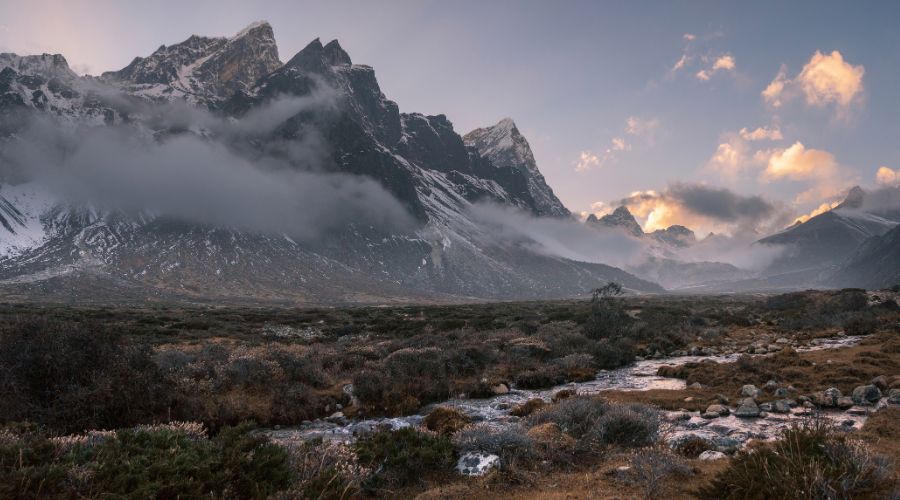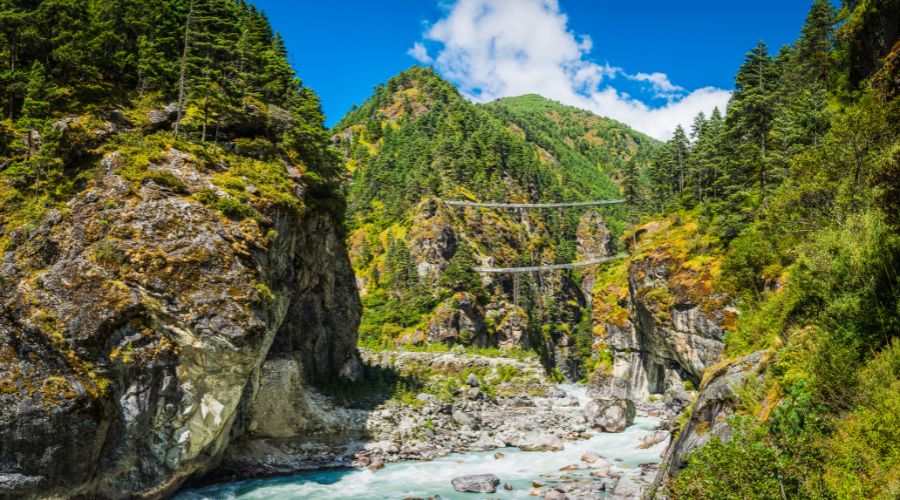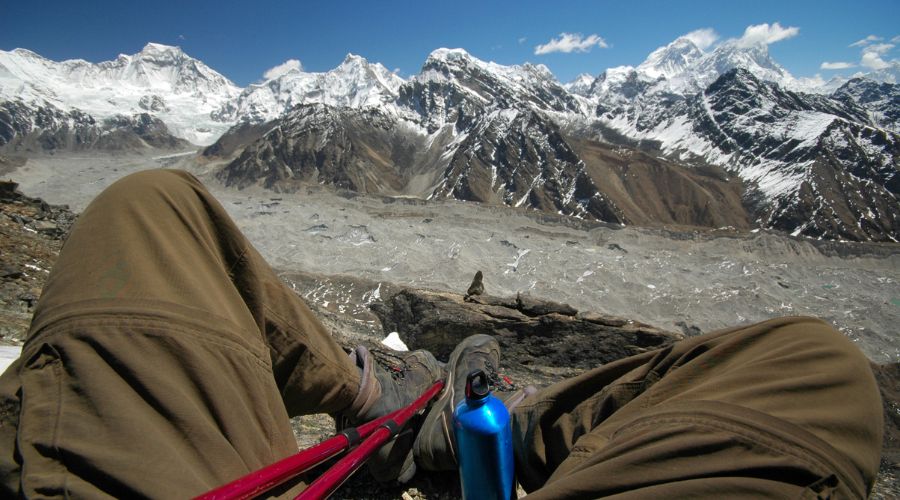
Everest Base Camp Trek in July

Everest Base Camp Trek in July
swotah travel
2471
04, 06 2023
The trek to the lap of the highest mountain in the world? Truly exhilarating! The Everest base camp is one of the most talked about treks in every corner of the earth for its surreal trail and adventurous experience. It is a 12- to 16 days long trek that is moderately difficult and risky. The Everest base camp trek starts from Lukla and passes through mountains, Buddhist shrines, potato fields, Thokla pass (4830 m / 15846.46 ft), Dense green forests, rivers, Sherpa settlements, etc. The maximum elevation one has to trek up to is 5364 m / 17598 ft. Despite having hard and risky trails this trek can be completed by newbies with little training and guidance.
The monsoon / rainy season in Nepal starts in July and ends in August; hence, July is the midpoint of the rainy season. This implies that the Everest base camp trek during July experiences very heavy and consistent rainfall. Usually, from the morning till midday, the weather is quite clear, but during the evening, it gets gloomy, and a downpour starts. So, does this mean the Everest base camp trek in July is not possible? Well, the answer is: It is very much possible if you do not mind getting a little soaked and following a few precautions.
WEATHER OF THE EVEREST BASE CAMP TREK IN JULY
Needless to say, July is very damp due to all the precipitation. But in places that have altitudes higher than 4000 m / 13123.36 ft, it does not rain as often. As the summer season falls right before the monsoon, the days are quite warm despite the rain. It is good for high-altitude treks like the Everest base camp trek as you won’t freeze from the cold. The evening and night are cool and pleasant. During the evening, clouds do tend to block the scenic view so it is better to keep the sightseeing plans during the morning.
The average maximum temperature of the Everest base camp trek in July is 17 degrees Celsius 62.6 degrees Fahrenheit, and the average minimum temperature is 0 degrees Celsius / 32 degrees Fahrenheit ( it does get below 0 degrees Celsius at very high altitudes, especially during the night). The maximum temperature in Lukla (starting point) is 18 degrees Celsius and the minimum temperature is 11 degrees Celsius / 51.8 degrees Fahrenheit. As the trek moves further ahead temperature consistently drops and gets to 0 degrees Celsius at Gorakshep. Heading ahead from Gorakshep to Pheriche and to the base camp there is a slight but gradual decrement in temperature up to -4 / -5 degrees Celsius. (24.8 degrees Fahrenheit / 23 degrees Fahrenheit.

Photo: A Serene Landscape: Khumbu Valley in the Deluge of July
FOOD AND ACCOMMODATION ON THE EVEREST BASE CAMP TREK IN JULY
Accommodations on the Everest base camp trek range from luxury hotels in city areas to teahouses. One of the perks of attempting famous treks like the Everest base camp during the off-season trek is less crowd, meaning more availability of rooms in teahouses. Some of the teahouses even provide hefty discounts as there is very less flow of trekkers. The price of hotels in Kathmandu and Pokhara ranges from $20 to $100+ (Nrs 2000 to Nrs 100000), depending on the luxury it provides. Now, talking about teahouses, a typical teahouse on the Everest base camp trek has a warm, cozy room with two beds and a shared bathroom. Rooms are facilitated with warm blankets and pillows. The price for a room per night costs from $3 to $15. However, Lobuche has a fixed price of $7. While choosing a teahouse, do not forget to ask if you are obliged to pay extra for hot showers, Wi-Fi, and using electricity (charging your electronics ) because some take extra while some have it included in the accommodation cost.
Staying in a luxury hotel gives you unlimited food options, but while staying in teahouses, it is limited. Generally, for breakfast, teahouses serve roti (pancake), tea, coffee, bread butter and jam, boiled eggs, milk, etc. For lunch, you can choose from noodles, dumplings, rice, thukpa, etc. Dinner typically consists of a staple Nepali meal, which is Dal and Bhat ( lentils and steamed rice ) served with a side of pickles, vegetables, spinach, and meat you can also eat thukpa, noodles, etc. for dinner. Dal bhat at Namche Bazar costs $5.30 (around 6000 Nrs, and at Gorakshep and Lobuche it costs around $10 / Nrs 1000 to $12 / Nrs 12000. Generally, $10 / Nrs 1000 each is more than enough for each meal of the day. Therefore $30 / Nrs 3000 - $40 / Nrs 4000 is assured to have your meal expenses per day covered.

Photo: July showers transform Khumbu Valley into a picturesque haven of greenery
PROS AND CONS OF TREKKING TO THE EVEREST BASE CAMP TREK IN JULY
PROS:
-
Less jammed trails (with people) make the trek relaxing and peaceful.
-
Easy to find rooms in the teahouses.
-
Rain cleanses dust, making the environment clean and exposing breathtaking scenarios after rain.
-
Rooms and food have off-season discounts.
-
Temperature that is neither too hot nor too cold.
-
Opportunity to be part of Saune Sankranti / Makar Sankranti and enjoy delicious meals like Khichadi, Puran Poli, Gur halwa, Til ko laddu, etc. (Saun is a Nepali month and falls in July, Sankranti is the first day of the month ).
CONS:
-
Trails can be damaged due to heavy and consistent rainfall.
-
Slippery and muddy trails are more prone to falls and accidents.
-
Sudden changes in weather delay flights, hampering your trek.
-
On gloomy days, views are hidden behind dark clouds.
-
Very high possibility of landslides and floods.
-
As trails are very damp and wet, there are more than usual mosquitoes and leeches.
-
Trekking in the rain can make you fall ill.
PERMITS THAT ARE REQUIRED IN JULY TO TREK TO THE EVEREST BASE CAMP:
Trekking through national parks always needs a permit, and as the Everest base camp trek traverses through the Sagarmatha national park one is expected to have a permit. There are two permits that one needs to complete this trek:
-
Khubu pasang Lhamnu rural municipality entrance permit / Trekkers Information Management System (TIMS card ) - $20 / Nrs 2000
-
Sagarmatha National Park entry permit - $30 / Nrs 3000
WHAT TO PACK FOR EVEREST BASE CAMP TREK IN JULY?
Since it is a rainy season, you need to pack your trekking bag with clothes and trekking gear that help you tackle the rain and protect from it.
-
Waterproof clothes (jackets, trousers, etc)
-
Carry an umbrella and raincoats.
-
Few warm sweaters.
-
Long sleeve tees to protect from insect bites.
-
Mosquito repellent
-
Gloves
-
Hat and sunscreen to protect from the sun
-
Waterproof trekking shoes that have a good grip even on muddy trails
-
Map or devices that help in navigation so that you do not get lost.
-
Power banks or solar chargers for places where teahouses charge extra for letting you charge the electronics).
-
All the necessary documents and permits for the trek.

WHAT ARE THE HIGHLIGHTS OF THE EVEREST BASE CAMP TREK IN JULY?
-
The awestruck view of an early morning sunrise from the best Everest viewpoint is Kalaptthar.
-
Visit the Tenzing Memorial stupa along with many other Buddhist shrines, mani walls, prayer flags, and Chortens.
-
The stunning sight of the Khumbu glacier (the biggest glacier in Nepal)and Khumbu icefalls.
-
Behold the sight of the longest glacier in Nepal (Ngozumba Glacier).
-
Explore the Sagarmatha National Park and its diverse wide range of flora and fauna.
-
Pay a visit to the Tengboache monastery (leading Buddhist center) situated at an altitude of 3867 m / 12687.01 ft.
-
Walk through high mountain passes namely Kongama La Pass, Cho La Pass, and Renjo La Pass.
-
Be awestruck by the terrific sight of Gokyo lakes.
-
The sight of glorious mountains like Mt. Everest, Mt. Ama Dablam, Mt. Makalu, Mt.Kwangde (6,011 m / 19721.13 ft), Mt.Thamserku (6,623 m / 21729 ft), Mt.Kangtega (6,782 m / 22250.66 ft), Nuptse Himal (7,861 m /25790.68 ft), Lhotse (8,516 m /27939.63 ft), etc.
-
Observe the lifestyle of Sherpa and Tibetans residing in the Everest region.
-
Behold the sight of yak pastures.
-
Traverse through beautiful Namche Bazar and dingboche.
-
Look in at the Hilary Museum.
-
Walk beside beautiful fast-flowing rivers like Kali Gandaki River, Imja River, Bhote Koshi River, etc.
SOME SUGGESTIONS TO MAKE YOUR EVEREST BASE CAMP TREK EASIER
Here are some suggestions from our side to help you trek safely in the Everest region amidst continuous rainfall:
-
The first and foremost thing to do is acclimatize enough to stay protected from mountain sickness.
-
Look at the weather forecast thoroughly before starting your trek while on the trek.
-
Search for authentic guides and porters who have proper certifications.
-
Always carry a first aid kit with you.
-
Since the Everest base camp trek is quite risky it is good to get travel insurance ( tick off the helicopter evacuation).
-
Before walking through landslide areas, check for possible dangers and only walk further ahead when the land is firm.
-
Practice responsible trekking to protect the aura of the Everest base camp do not harm it in any way.
NEWSLETTER SIGNUP
Sign up to receive our trip ideas and travel offers!
Get updates and Exclusive Offers up to 20% Discount








